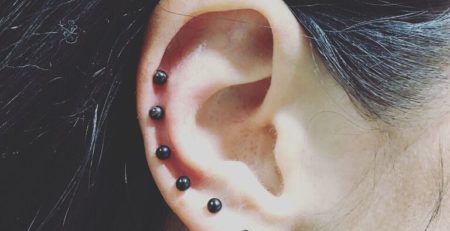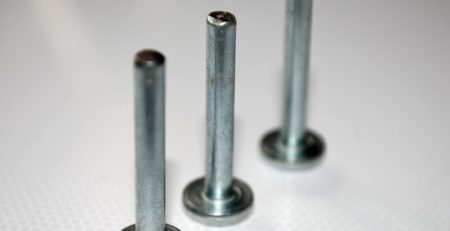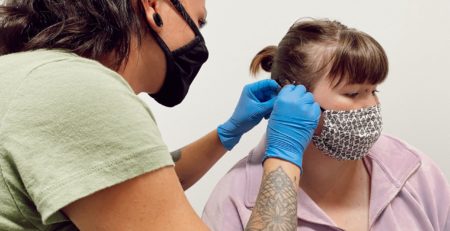Body Piercing FAQs
Body piercings have been a form of self-expression and cultural significance for centuries. From the classic earlobe to more intricate body modifications, piercings are a popular way to showcase individuality and style. If you’re considering getting a piercing or just curious about the process, here are answers to some frequently asked questions to help guide you through the journey.
What are the most common types of body piercings?
Body piercings come in a variety of styles, each with its own unique appeal. Some of the most common types that we do include:
• Earlobe Piercings: One of the most traditional and popular, often done with a standard needle. These are so popular because people of all ages get them.
• Cartilage Piercings: Located in the upper part of the ear. The most common is a cartilage rim piercing, also known as a helix.
• Navel (Belly Button) Piercings: These are popular for body adornment. People often get them in the off season so that they’re ready to show off for Summer!
• Nostril Piercings: Nostril piercings have become so incredibly common so they are by far and away one of our most popular piercings. They’ve become accepted in almost all lines of work and people of all ages get them.
How do I choose the right piercing for me?
Choosing a piercing depends on various factors including personal style, pain tolerance, and aftercare commitment. Consider these tips:
• Personal Style: Think about where you want the piercing and how it fits with your existing body art or jewelry. Also think about if you can have it at work, in sports you play, or any other activities you may be a part of.
• Pain Tolerance: Different piercings have different pain levels. For instance, earlobe piercings are typically less painful compared to cartilage piercings. While there is almost always some degree of pain with getting a piercing, the process is so quick that by the time you feel any pain, it is done!
• Healing Time: Some piercings take longer to heal than others. For example, a navel piercing can take up to a year to fully heal, while an earlobe piercing may heal in 6-8 weeks.
What should I expect during the piercing process?
The piercing process generally involves:
• Consultation: You’ll fill out paperwork and pick out jewelry. Discuss your preferences and any concerns with the piercer.
• Preparation: The area will be cleaned, and the piercer will mark the spot and have you check it out to ensure proper placement.
• Piercing: The actual procedure usually takes only a few seconds. The piercer will use a sterile needle to create the hole and insert the jewelry.
• Aftercare Instructions: You’ll be given guidelines on how to care for your new piercing to avoid infections and ensure proper healing.
How should I care for my new piercing?
Proper aftercare is crucial for a healthy piercing. Here are some key steps:
• Cleanliness: Clean the piercing site with our “Soak-It!” sea salt, “Wash-It!” glycerin soap, and for oral piercings, the “Rinse-It!” mouth rinse. Avoid using alcohol or hydrogen peroxide as they can be too harsh and bactines or ointments as they can clog the piercing.
• Avoid Touching: Keep your hands off your piercing to prevent introducing bacteria unless you have just washed them.
• Jewelry Care: Make sure your jewelry is made of high-quality materials like titanium or surgical steel to minimize irritation. You’ll want jewelry that is long enough or large enough to allow for swelling for the healing portion and that can switch to tighter fitting jewelry.
• Avoid Irritants: You’ll want to steer clear of swimming pools, hot tubs, and lakes for 6-8 weeks unless covered with a “Cover-It!” kit.
How long does it take for different piercings to heal?
Healing times vary depending on the piercing and individual factors. Here’s a general guide:
• Earlobe: 6-8 weeks
• Cartilage (Helix, Tragus, Conch, Industrial, Rook, Daith, etc): 6-12 months
• Navel: 6-12 months
• Nose (Nostril): 2-4 months
• Eyebrow: 2-4 months
• Lip and Labret: 6-8 weeks
What should I do if I experience complications?
If you notice signs of infection such as redness, swelling, pain that is worse than when you got it pierced, drainage that is greenish and/or bloody, or a random fever, it’s important to:
• Clean the Area: Gently clean the piercing with provided aftercare.
• Avoid Removing Jewelry: Unless advised by a professional, keep the jewelry in place to prevent closing.
• Consult a Professional: Contact your piercer or a healthcare provider for advice and next steps.
Can I change my jewelry right away?
It’s best to wait until the piercing is fully healed before changing jewelry. Changing it too early can lead to complications or start the healing process over.
Are there any risks associated with body piercings?
Like any procedure, body piercings come with risks such as infection, allergic reactions, rejection, or scarring.
• We wish there was a sure way to prevent infection but unfortunately, it’s always a possibility. However, you can drastically lower your risk of infection by getting pierced at a reputable shop, only touching your piercing wish freshly washed hands, and keeping the piercing area clean by using aftercare.
• Allergic reactions – If a person breaks out from watches or belt buckles, we always recommend getting pierced with titanium jewelry. This is because titanium doesn’t contain nickel and that’s typically what people have allergies to. Our 14k gold and surgical steel options are still good quality and have only traces of nickel as well.
• Scarring – This can be possible with any piercing but some scars such as that of a nostril piercing or a cartilage may have a very small scar where dermals or other surface piercings (navel, eyebrow, anti-eyebrow, surface tragus, etc) might leave a more noticeable scar.
• Rejection – This is when the body treats the body jewelry like it would a sliver or foreign object and tries to push it outwards. Snagging your jewelry can begin this process so it’s important to avoid ill-fitting jewelry, unless your piercing is fresh and in the healing phase. Keeping a consistent aftercare routine can also really help this.
Conclusion
Body piercings can be a fantastic way to express yourself and enhance your look, but it’s important to approach them with care and knowledge. By understanding the types of piercings, the process, and aftercare, you can ensure a positive experience and beautiful results. Whether you’re getting your first piercing or adding to your collection, remember that patience and proper care are key to enjoying your new body art.














Leave a Reply